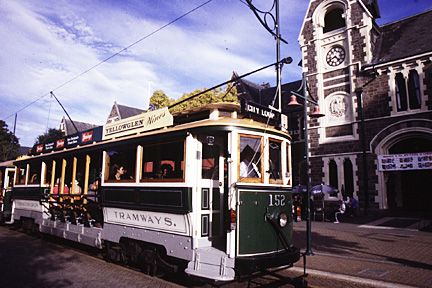
On the cover: A town tour is available via tram that loops every 30 minutes through the town center.
England of the
South Pacific
Christchurch represents New Zealand’s
best with its rich heritage, natural beauty
and modern conveniences
 New Zealand is famous for its natural beauty depicted in the "Lord of the Rings" film trilogy. But it also offers urban attractions to please even the most sophisticated traveler, especially in Christchurch, often called the most English place outside Great Britain. Hawaii's good fortune is that New Zealand, with moderate climate year-round, is one of our closest international neighbors. You can hop on a midnight flight, wake up in Auckland at 8 a.m. and catch a quick connecting flight south to Christchurch in time for lunch.
New Zealand is famous for its natural beauty depicted in the "Lord of the Rings" film trilogy. But it also offers urban attractions to please even the most sophisticated traveler, especially in Christchurch, often called the most English place outside Great Britain. Hawaii's good fortune is that New Zealand, with moderate climate year-round, is one of our closest international neighbors. You can hop on a midnight flight, wake up in Auckland at 8 a.m. and catch a quick connecting flight south to Christchurch in time for lunch.
With a population of about 330,000, Chirstchurch is New Zealand's third-largest city, after Auckland and Wellington. Parts of downtown Auckland certainly are pedestrian-friendly, and Queenstown has a more picturesque mountain lake setting, but Christchurch, the largest town on the South Island, is considered by many to be the most appealing New Zealand city.
It is a medium-size, people-oriented city designed to a human scale, with regard for historic preservation. Yet Christchurch is large and modern enough to offer exciting activities, entertainment, shops and restaurants, many concentrated in the small downtown Central City, about six blocks wide and long.
Prices here are reasonable because this is one of the few modern countries where the dollar is still strong. Restaurants are less pricey than Honolulu, with excellent quality and variety of cuisine. You also get a good value when purchasing locally made handicrafts, clothing, jewelry, sheepskins, wines and food.
The surrounding countryside will also lure you, especially the Southern Alps, a rugged range of glacier-topped peaks a few hours to the west, easily reached by train.
The countryside's natural beauty has been preserved by a government restriction on suburbs, which can only extend up to a perimeter line around the city.
Christchurch was to be the new, little England of the South Pacific, protected in a way similar to "greenbelts" established around British cities.
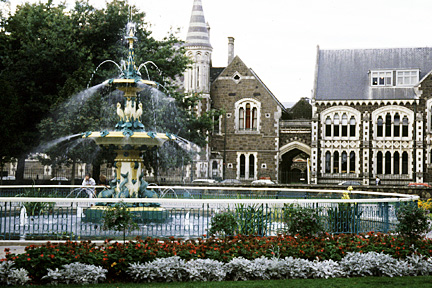
Christchurch Arts Centre is especially festive on weekend mornings when artists set up booths outdoors.
 The Cathedral, Avon River and Botanical Gardens
The Cathedral, Avon River and Botanical Gardens
These three major sites will easily take up most of your morning. An introductory tour is offered via an old-fashioned tram that runs in a 2-mile loop through the town center. Board one of the 1905 vintage trolley cars in Cathedral Square for a 30-minute loop. Newly laid tracks provide a comfortable ride in trolleys powered by overhead electric wires, as in the old days.
Tourists are the only passengers because the short loop is impractical for commuters. (The nation's capital, Wellington, has a commuter tram system that helps ease traffic.)
A conductor points out sights as you roll along. A two-day pass is available, but a one-hour ticket should allow enough of an overview to help you start your explorations on foot.
Start at Cathedral Square, designed from Christchurch's beginnings in 1850 to be the focal point of the street grid that extends in all directions. Everything of interest revolves around this square.
The cathedral was designed in the Neogothic style by Sir George Gilbert Scott, who designed such landmarks as St. Pancras Station and the Albert Memorial in London, and two chapels at Oxford University. Christchurch Cathedral might be the most important building in the country, with its pointed arches, heraldic banners and carved pulpit. It's also the site of free choral concerts are offered at 5:15 p.m. Tuesdays and Wednesdays, and 4:30 p.m. Fridays.
Cathedral Square represents the geographic, spiritual and historic center of town: The first main settlement of Christchurch was the result of a religious movement led by John Robert Godley, who feared the looming "age of equality" and possible collapse of religion in his native England. His bronze figure stands in front of the cathedral, although he returned to England only a few years after his arrival in 1850. Overshadowing his statue is the giant new "Chalice" sculpture installed to celebrate the 150th anniversary of Christchurch's founding. The 60-foot cone is 4 feet wide at its base, flaring to 25 feet at the top.
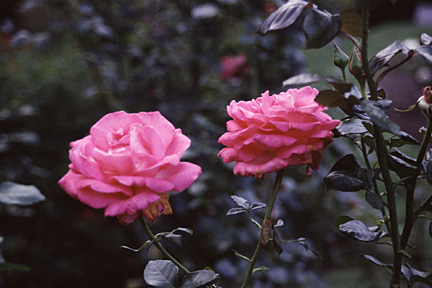
Christchurch Botanic Gardens displays why Christchurch is known as the "City of Gardens."
From the cathedral, stroll a block west along Worcester Boulevard to picturesque Avon River. On the way, you'll see the Old Municipal Chambers (1887) housed in a classic Victorian-style brick structure. Outside is a bronze relief of Kate Sheppard and other women, symbolizing New Zealand's status as the first country allowing women to vote 100 years ago, and a sculpture of English explorer Capt. Robert Scott.
Scott was racing to be first to the South Pole in 1912 but arrived just after Roald Amundsen. Scott died just a few miles from home base on his return trip and became a hero to the British and New Zealanders. He is commemorated by this statue sculpted by his widow, who also created another version that stands in Waterloo Place, London. Christchurch is still a major departure point for Antarctic expeditions because it is the closest large settlement to the pole.
Avon River: This small river is lined on both banks by a pretty park, bringing the countryside through the heart of Christchurch, contributing to the town's beauty. Many sights and activities are clustered along the Avon. Oxford Terrace's cafes are good places to mingle with locals.
One walking strategy is to stroll about five miles up and down both sides of the Avon, bringing you through the center of town and through some beautiful gardens. To do this, start at the visitor center and walk south along the river's far bank for two blocks on Cambridge Terrace under shade trees. You'll see flocks of ducks and other fowl splashing around in the tranquil waters. Notice two historic buildings on the first and second corners: the Canterbury Club, founded in 1872 for gentlemen, with original hitching post and gas lamp out front, and the Old Library Chambers (1876). The next landmark is the Bridge of Remembrance memorial to World War I, which leads across the Avon to the City Mall pedestrian shopping zone.
At the point the river bends westward lies another important church, St. Michael's. It was built in 1851 as the town's first church, then reconstructed in 1872 in a Victorian gothic style. This white, wooden "Mother Church" has an excellent stained glass collection and intricate bell tower.
Punting: Continuing along Cambridge Terrace another block to Rolleston Avenue will bring you to the historic Antigua Boatsheds (1882). There, you can go on a boat ride through the Botanic Gardens in a traditional punt, a small boat pushed along with a pole by a punter who will share stories about Christchurch. Punts operate from 9 a.m. (10 a.m. in winter) until dusk daily, but the ride is so popular it would be wise to make a reservation (phone 03-366-0337; fax 03-377-5801). You could also rent a canoe or paddle boat, but it is much more fun in a punt.
The river banks are named Oxford and Cambridge Terraces after the English university towns whose students began the punting tradition.
Botanic Gardens: After the punt ride, walk from the boat ramp up Rolleston Avenue to the Botanic Gardens. Christchurch is known as the "City of Gardens" because its residents love to surround their homes with flora; prizes in big annual contests are at stake. This passion is evident in the Botanic Gardens, open free all day.
Starting at the Peacock Fountain at the gardens' eastern entrance next to the Canterbury Museum. One section at the back, the Cockayne Memorial Gardens, is devoted to the largest collection of indigenous trees and shrubs on the island. Exotic plants also can be found, especially in the Rose Garden, with its 250 varieties. There are also herb, rock, water and fern sections, and several culinary and medicinal plants.
This garden is a great place to hang out any time, but more flowers bloom from December through February, their summer. Plant lovers could spend a few hours here; others should get at least as far as the central rose garden. The loop path around the park perimeter is an especially pleasant route. For more greenery, the larger Hagley Park surrounds the gardens with playing fields, woodlands and a few ponds.
Notable buildings: After a park visit, head north up Rolleston Avenue to Christ's College, an elite private school for 600 boys in the British tradition of Eton and Harrow. Started in 1857, a few years after Christchurch's founding, most of its stone buildings were built in the 1920s in Neogothic style, laid out around a central quad.
Turn right on Armagh Street to reach Cranmer Square, a grassy open space occupying two tree-surrounded blocks. Several nice hotels are located here, and some classic old buildings, including the former Girls' High School and Normal School, are now carved into apartments. Continue on Armagh another block to Durham Street and the Provincial Government Buildings, considered to be the most beautiful Neogothic buildings in New Zealand, almost like a European medieval village. They were designed by Benjamin Mountfort, Canterbury's leading Gothic Revival architect. Admire the buildings from the outside or peek inside the Council Chamber (1865), built of stone and wood, with stained glass, mosaics and an impressive barrel-vaulted roof. It's open free from 10:30 a.m. to 3 p.m. Mondays to Saturdays.
Victoria Square: Cross the Avon again to Victoria Square, once the commercial heart of town and present site of Town Hall, a large performing arts complex and convention center. Statues of Queen Victoria and Capt. Cook stand in the square, along with a large floral clock and water fountain. Another block brings you to a 24-hour casino.
Finish your walk by heading south two blocks to Cathedral Square; or if you have time and interest, continue east another eight blocks along the Avon to the Edmonds Band Rotunda, and just beyond, to a spot where the river is flanked by two rows of majestic poplars. Passing through this cathedral of trees is a divine experience and will bring you to Madras Street, then Latimer Square and its surrounding attractive, two-story wooden houses.
Pedestrian malls: At Latimer Square, turn west and walk two blocks to New Regent Street, another fine pedestrian area lined with shops and cafes. The main pedestrian district, City Mall, lies two blocks south, stretching toward the river as an extension of Cashel Street.
It could take many hours to cover Gloucester, Worcester, Hereford and Cashel streets and their cross streets, comprising about 25 city blocks filled with retail and dining establishments.

Go on a boat ride through the Botanic Gardens in a punt, a small boat pushed along with a pole by a punter who will share stories about Christchurch. Punts operate until dusk daily, but the ride is so popular, it would be wise to make a reservation.
 The Arts Centre, Canterbury Museum and Christchurch Art Gallery
The Arts Centre, Canterbury Museum and Christchurch Art Gallery
The Arts Centre: Once the Canterbury University, the school moved out more than 30 years ago to a new campus on the edge of town, and the artists took over. Artists set up studios and retail space in what is now a classy shopping mall for the arts just a few blocks from Cathedral Square along the tourist tram route. It's open daily but is especially festive on weekend mornings when artists set up booths outdoors.
Here, you will find handmade jewelry, clothing, wood carvings, leather goods, ceramics, statues and paintings in a range of styles, all available for purchase directly from their creators. This is one of the most wonderful arts collectives anywhere in the world, with more than 100 artists working here. I watched one woman at a spinning wheel, producing wool she knit into sweaters, and visited a weaver making a fabric portrait copied from a photograph.
It's a great opportunity to meet artists and learn about their works. Maori craftsman Jeff Mahuika introduced me to New Zealand jade, "which can be found only on the South Island, with the richest sources on the West Coast," he said.
"This was a treasure for our people because of its hardness," he added, explaining that the jade was used to make stone tools such as chisels and adzes.
Another artist, Darren Rogers, uses 17th-century pewter he imports from England and techniques he learned in Maryland to create picture frames and pendants with Maori themes, including fishhooks and tikis. Other craftsmen make jewelry and small sculptures from bone, wood and precious stones.
The center also features cafes, restaurants and some night life, with stage, music and ballet productions in the Court Theater and a busy social scene. There is an astronomy observatory you can enter for a small fee, and you can also visit the science laboratory of John Rutherford, who won the Nobel Prize for his work in radiation a century ago.
Canterbury Museum: This natural-history museum is noted for its large bird collection, Maori and South Pacific Islander cultural displays, plus fascinating exhibits about the 19th- and 20th-century settlement of New Zealand, and Antarctic expeditions that began at Christchurch.
Dioramas depict daily activities in the time before Western contact. Cases display traditional artifacts, and some large tikis and other woodwork stand in the galleries. There is also an impressive reconstruction of a 19th-century street with original shop fronts and authentic merchandise. It's on par with Smithsonian Institution exhibitions. Extensive decorative arts sections comprise silverware, costumes and ceramics used by early European settlers.
Christchurch Art Gallery: This stunning new art museum is a block from the Canterbury Museum on Montreal and Worcester streets. Opened in 2003, this glass-and-steel structure rivals any of the world's great new museums. You might find the building design more compelling than the artwork inside. It occupies a block, displaying paintings, prints, ceramics, textiles, photographs and sculpture. The 5,000 items in the collection were created primarily by Canterbury-region artists, but some Europeans are also represented in galleries open daily, with free admission. Art lovers might also enjoy a visit to the Centre of Contemporary Art, just around the corner on Gloucester, with five galleries housing recent works by local artists.
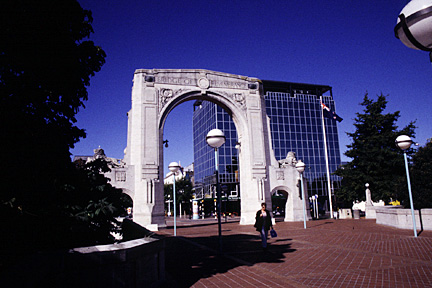
The Bridge of Remembrance, a World War I memorial, leads across the Avon to the City Mall pedestrian shopping zone.
 The Alps
The Alps
There are several activities to enjoy around Christchurch, including bungee jumps, spas, coastal tours, skiing, golf, hot-air ballooning, biking, ice skating, whale-watching, wind surfing, white-water rafting, kayaking, fishing, wine tasting, hiking, sky diving, paragliding -- you get the picture.
Museums nearby include the Air Force Museum, Science Alive, Ferrymead Heritage Park, Southern Encounter Aquarium and the International Antarctic Centre. Orana Park and Willowbank are popular animal preserves, and the Marae of the Four Winds focuses on Maori culture, offering evening shows and a "hangi" (luau) meal. More information can be found on the city Web site, www.christchurch.org.nz.
Tranz scenic train: Perhaps the best activity on your third day is a train ride into the Southern Alps, a half- or full-day journey. Most will find the half-day version just right. It includes most of the rugged mountain scenery without getting repetitious. Various package tours will bring you from Christchurch to the mountains by bus and rail.
The train offers a choice of sitting in a modern, enclosed car, with comfortable padded seats, air conditioning and picture windows, or an open outdoor car that affords a better view for photographers and fresh-air fiends.
This train played an important role for nearly a century, getting farm goods to market and supporting gold-mining activities on the west coast. Now it primarily serves day-tripping tourists.
This train ride traverses lush farmlands, rivers and ravines of the Canterbury Plains, the country's largest stretch of level land, to bring you to the center of New Zealand's major mountain range.
The full-day train route goes from Christchurch to Greymouth on the west coast, taking more than four hours one way; or go halfway to Arthur's Pass, have lunch at the Chalet, and return to Christchurch via tour bus by early afternoon. This leaves a little time for catching up on activities and sights missed earlier, and figuring out how to squeeze in a few more days for this heavenly destination.
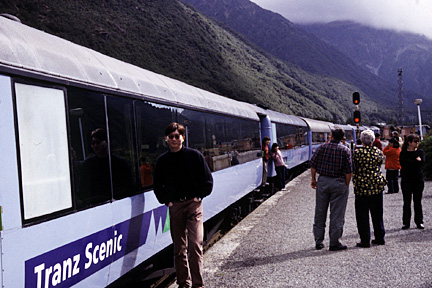
View lush farmlands, the rivers and ravines of the Canterbury Plains and rugged mountains aboard the Tranz scenic train with your choice of modern, enclosed cars or open outdoor cars.
If you go ...
Here are a few places to stay and visit while in Christchurch. Dial 011-64-3 when calling from the United States:HOTELS
» Holiday Inn City Centre: At Cashel and High streets. Call 365-8888, fax 364-5143 or e-mail reservations@hicitycentrechristchurch.co.nz; www.holidayinn.co.nz
» Hotel Casion: 71 Kilmore St. Call 377-7168, fax 377-7168 or e-mail casion@snap.net.nz; www.casionhotel.co.nz
» Copthorne Central Hotel: 776 Colombo St. Call 379-5880, fax 365-4806 or e-mail copthorne.central@mckhotels.co.nz; www.copthornecentral.co.nz
» Hotel Camelot: 66 Cathedral Square. Call 365-2898, fax 379-2388 or e-mail camelot.cathedral@xtra.co.nz; www.thecamelot.co.nz
» Heritage Hotel: 28-30 Cathedral Square. Call 377-9722, fax 377-9881 or e-mail res@heritagehotels.co.nz; www.heritagehotels.co.nz
» Hotel Latimer: 30 Latimer Square. Call 379-6760, fax 366-0133 or e-mail enquiries@latimerhotel.co.nz; www.latimerhotel.co.nz
» Rydges Hotel: Worcester Street and Oxford. Call 379-4700, fax 379-5357 or e-mail reservations_christchurch@rydges.com; www.rydges.com
» Grand Chancellor Hotel, 161 Cashel St. Call 379-2999, fax 379-9929 or e-mail res@grandc.co.nzATTRACTIONS
» Air Force Museum: The history of flight in New Zealand. Open 10 a.m. to 5 p.m. daily. Call 343-9532; www.airforcemuseum.co.nz
» The Arts Centre: Galleries, studios and shops at 2 Worcester Boulevard. Open daily. Call 363-2836; www.artscentre.org.nz
» The Botanic Gardens: Exotic and indigenous plants at Rolleston Avenue. Open 7 a.m. to closing an hour before sunset. Call 366-1701; www.ccc.govt.nz/parks/BotanicGardens
» Canterbury Museum: Historic and natural collections at Rolleston Avenue, open 9 a.m. to 5:30 p.m. daily. Call 366-5000; www.canterburymuseum.com
» Centre of Contemporary Art: 66 Gloucester St. Open 11.00 a.m. to 5.00 p.m. Tuesdays to Fridays, and noon to 4 p.m. weekends. Call 366-7261; www.coca.org.nz
» Christchurch Art Gallery: On Montreal Street. Call 365-0915; www.christchurchartgallery.org.nz
» Christchurch Casino: 30 Victoria St., open 24 hours daily. Call 365-9999; www.chchcasino.co.nz
» Christchurch Gondola: 360-degree panoramic views of Christchurch at 10 Bridle Path Road, Heathcote. Open from 10 a.m. daily. Call 384-0700; www.gondola.co.nz
» Christchurch Tramway: Open 9 a.m. to 6 p.m. April 1 through Oct. 31, and 9 a.m. to 9 p.m. Nov. 1 to March 31. Call 366-7830; www.tram.co.nz
» Ferrymead Heritage Park: Colonial Christchurch exhibits open 10 a.m. to 4:30 p.m. daily at Ferrymead Park Drive. Call 384-1970; www.ferrymead.org.nz
» Antarctic Centre: Orchard Road (next to Christchurch Airport), open 9 a.m. to 5p.m. daily; www.iceberg.co.nz
» Harbour Cruises: Offered by Black Cat Group. Call 329-9078; www.blackcat.co.nz
» Mona Vale Gardens: Garden tour of a late-Victorian homestead at 63 Fendalton Road, Riccarton. Open 9:30 a.m. to 4 p.m. daily. Call 348-9660.
» Nga Hau E Wha Marae: Introduction to Maori culture and history at 250 Pages Road, Aranui. Guided tour at 11 a.m. or 2 p.m. daily. Call 388-7685.
» Orana Wildlife Park: 743 McLeans Island Road. Open 10 a.m. to 4:30 p.m. daily. Call 359-7109; www.oranawildlifepark.co.nz
» Science Alive!: Science and technology exhibits at 392 Moorhouse Ave., open 10 a.m. to 5 p.m. daily. Call 365-5199; www.sciencealive.co.nz
» Southern Encounter Aquarium and Kiwi House: Cathedral Square, open 9 a.m. to 9 p.m. daily; 10 a.m. to 6 p.m. during winter. Call 377-3474; www.southernencounter.co.nz
» Willowbank Wildlife Reserve: Wildlife park at 60 Hussey Road. Open 10 a.m. to 10 p.m. daily. Call 359-6226; www.willowbank.co.nzWEB SITES
» www.aaguides.co.nz
» www.christchurch.org.nz
» www.christchurchnz.net
» www.tranzscenic.co.nz
[News] [Business] [Features] [Sports] [Editorial] [Do It Electric!]
[Classified Ads] [Search] [Subscribe] [Info] [Letter to Editor]
[Feedback]
